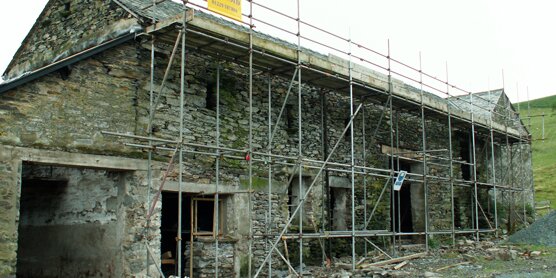Building Value: public benefits of historic farm building repair in the Lake District

As well as contributing to the quality of the landscape and its enjoyment by the public, the maintenance of historic buildings creates employment, supports local economies and sustains craft skills. A project commissioned by English Heritage and Defra has evaluated these effects in detail for the Lake District National Park.
In 2005, English Heritage and Defra, in partnership with the Lake District National Park Authority, commissioned ADAS UK and the Countryside and Community Research Unit of the University of Gloucestershire to undertake an evaluation of the social, economic and public benefits of the long term programme of repairs to traditional farm buildings undertaken through the Defra funded Lake District Environmentally Sensitive Area (ESA) Scheme.
The evaluation project focused on the period 1998 to 2004, during which Defra’s investment in grants has totalled over £6.2 million. The project sought to rigorously define the benefits delivered by this repair programme in addition to the important heritage conservation work which was its primary objective. These collateral benefits include the creation of employment, inputs to the local economy, support for craft skills, advantages to farm businesses and landscape enhancement from the perspective of residents and visitors.
Background to the funding schemes
The ESA scheme, delivered by the former Rural Development Service, now part of Natural England, covers most of the Lake District National Park, with the objective of protecting its landscape, wildlife and heritage by offering incentives to landowners to farm their land in an environmentally sensitive manner. The scheme included payments for repairs to working historic farm buildings which are to be kept in agricultural use. Since its establishment in 1993, the scheme has supported over a thousand repair projects, with specialist advice on building conservation provided by the National Park Conservation Officer.
Findings
Allowing for additionality, displacement and multiplier effects, the key findings of the project were that:
- 71% of local groups, 60% of domestic visitors and 63% of international visitors rate the Lake District’s sense of history and tradition as extremely or very important.
- During the study period over 450 conservation plans covering more than 655 buildings, including 35 listed buildings were agreed.
- Without the ESA scheme, two thirds of these buildings were likely to become derelict and the remainder repaired to a lower standard not in keeping with local character
- The scheme has ensured a viable future for nearly 65,000 square metres of historic building floor space, with 92% of the buildings repaired now in productive use and the majority of farmers reporting an improvement in the efficiency of their business
- Grant recipients contributed £1.62 million towards the cost of the repairs.
- Building work was carried out by 30 local firms, creating between 25 and 30 full time equivalent jobs in the local economy, at least half of which were generated through direct employment on building projects.
- Allowing for direct, indirect and induced effects, the scheme has resulted in a total injection of between £8.5 million and £13.1 million to the local economy, with every £1 expenditure on repair work resulting in a total output within the ESA of £2.49.
- The retention of revenue generated by these repair projects in the local economy is substantial, reflecting the fact that local building contractors are carrying out the work, a significant proportion of their staff and supplies are sourced locally, and that local households spend a fair proportion of their disposable income in the immediate area.
- A significant pool of historically significant buildings remains within the National Park which would benefit from entry into the ESA or its successor Environmental Stewardship scheme.
This is report 1 of the Valuing the Historic Environment series, which provides new research into the social and economic value of heritage.
What's New?
-
The National Heritage List for England is now live on the English Heritage website.
-
Welcome to the HER21 page. This page offers access to the full suite of HER21 project reports.
